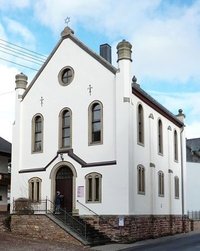Mezuzot are small script capsules affixed to house entrance doorposts, as well as on almost every other doorway in the Jewish home. While they are often decorated with ornaments, this mezuzah has an altogether plain case. The case is made of undecorated metal material with a small hole for mounting. This casing was once used in Siegerland, but similarly designed objects can be found in the Rhine-Hunsrück region. It is exemplary for the simple design of the ritual items quite often found in the rural Jewish communities.
The script capsule contains a parchment roll with verses from the “Shema Yisrael” (‚Hear, O Israel‘, Deuteronomy 6:4–9 and 11:13–21) from the Jewish profession of faith. It also contains the commandment to "Inscribe the prayer on the doorposts: "Write them upon the doorposts of your house..."
The text is handwritten onto a piece of parchment by a so-called Sofer, who then rolls it together to preserve it in a casing made of wood, metal or porcelain (or some other material). As with this mezuzah, the backside of the parchment is marked with the Hebrew letter „Shin“ (שּ). It is the symbol for „Schaddai“, an abbreviation for one of the many names of God and, in this context, bears the meaning „Guardian of Israel's doors“.
The case is mounted onto doorpost to the right of the person entering and tilted slightly towards the room. Many observant Jews touch the mezuzah when they enter a room by laying the fingertips of their right hand on the mezuzah and then drawing them to the mouth. The mezuzah also symbolizes that God watches over and protects this house. At the same time, it serves as a constant reminder to observe God's commandments.
en

